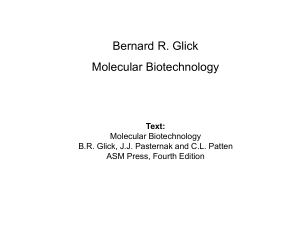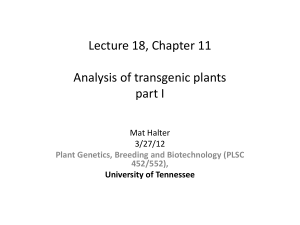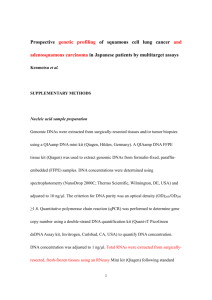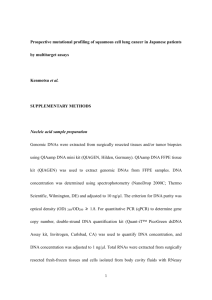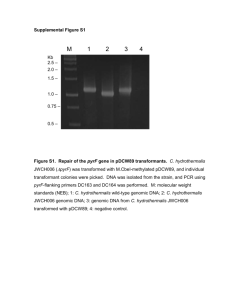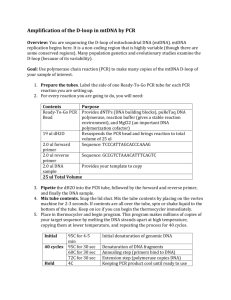pbi12057-sup-0001-DataS1
advertisement
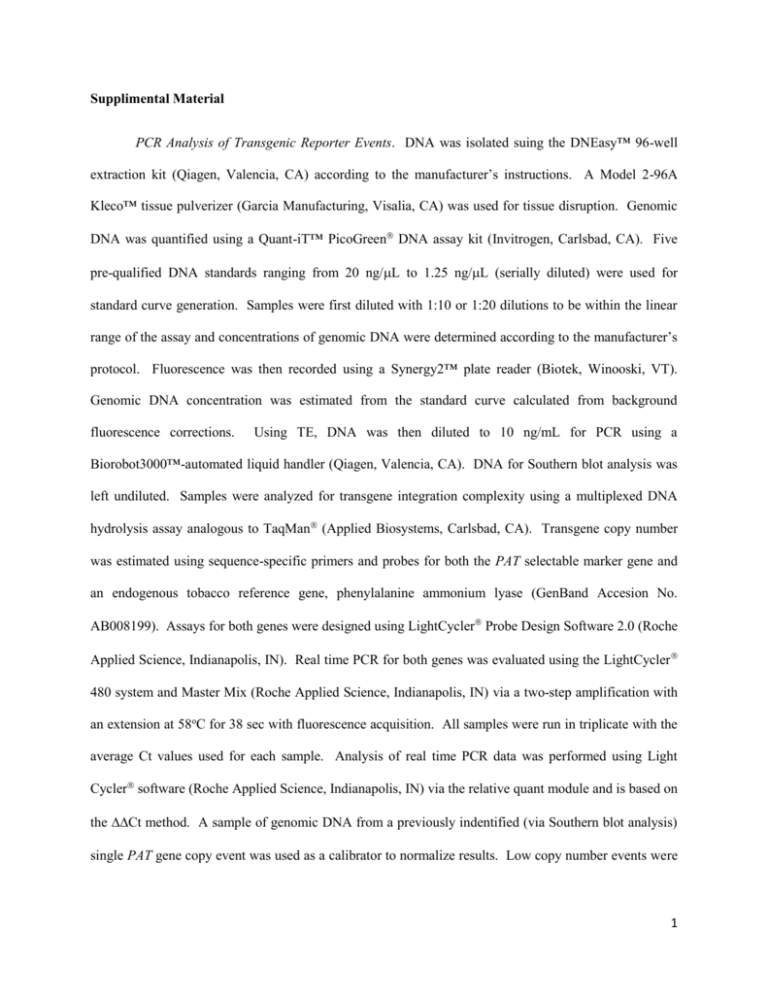
Supplimental Material PCR Analysis of Transgenic Reporter Events. DNA was isolated suing the DNEasy™ 96-well extraction kit (Qiagen, Valencia, CA) according to the manufacturer’s instructions. A Model 2-96A Kleco™ tissue pulverizer (Garcia Manufacturing, Visalia, CA) was used for tissue disruption. Genomic DNA was quantified using a Quant-iT™ PicoGreen DNA assay kit (Invitrogen, Carlsbad, CA). Five pre-qualified DNA standards ranging from 20 ng/L to 1.25 ng/L (serially diluted) were used for standard curve generation. Samples were first diluted with 1:10 or 1:20 dilutions to be within the linear range of the assay and concentrations of genomic DNA were determined according to the manufacturer’s protocol. Fluorescence was then recorded using a Synergy2™ plate reader (Biotek, Winooski, VT). Genomic DNA concentration was estimated from the standard curve calculated from background fluorescence corrections. Using TE, DNA was then diluted to 10 ng/mL for PCR using a Biorobot3000™-automated liquid handler (Qiagen, Valencia, CA). DNA for Southern blot analysis was left undiluted. Samples were analyzed for transgene integration complexity using a multiplexed DNA hydrolysis assay analogous to TaqMan (Applied Biosystems, Carlsbad, CA). Transgene copy number was estimated using sequence-specific primers and probes for both the PAT selectable marker gene and an endogenous tobacco reference gene, phenylalanine ammonium lyase (GenBand Accesion No. AB008199). Assays for both genes were designed using LightCycler Probe Design Software 2.0 (Roche Applied Science, Indianapolis, IN). Real time PCR for both genes was evaluated using the LightCycler 480 system and Master Mix (Roche Applied Science, Indianapolis, IN) via a two-step amplification with an extension at 58oC for 38 sec with fluorescence acquisition. All samples were run in triplicate with the average Ct values used for each sample. Analysis of real time PCR data was performed using Light Cycler software (Roche Applied Science, Indianapolis, IN) via the relative quant module and is based on the Ct method. A sample of genomic DNA from a previously indentified (via Southern blot analysis) single PAT gene copy event was used as a calibrator to normalize results. Low copy number events were 1 screened by PCR for intact gus gene transcription units. Primers were used which amplified a 3.7 kb product consisting of the ZFP-Act2/GUS/ORF23 sequence. Southern Blot Analysis of Transgenic Reporter Events. For each event displaying low copy PAT gene integration and an intact gus gene transcription unit based on PCR, 5 g of genomic DNA was thoroughly digested with AseI (New England Biolabs, Ipswich, MA) by incubation at 37 oC overnight. The digested DNA was concentrated by precipitation with Quick Precip™ Solution (Edge Biosystems, Gaithersburg, MD) according to the manufacturer’s suggested protocol. The genomic DNA was then resuspended in 25 L water at 65oC for 1 h. Resuspended samples were loaded onto a 0.8% agarose gel prepared in 1X TAE buffer and electrophoresed overnight at 1.1 V/cm. The gel was immersed in neutralization buffer (0.5 M Tris-HCl, pH 7.5 and 1.5 M NaCl) for 30 min. Transfer of DNA fragments to nylon membranes was performed by passively wicking 20X SSC buffer overnight through the gel onto treated Immobilon™-NY+ transfer membrane (Millipore, Billerica, MA) using chromatography paper wick and paper towels. Following transfer, the membrane was briefly washed with 2X SSC, cross-linked with the Stratalinker 1800 (Strategene, La Jolla Ca.) and vacuum baked at 80oC for 3 hours. Blots were incubated with pre-hybridization solution, PerfectHyb™ Plus (Sigma-Aldrich, St. Louis, MO) for 1 h at 65oC in glass roller bottles using a Model 400 hybridization incubator (Robbins Scientific, Sunnyvale, CA). Probes were prepared from a PCR fragment containing the entire GUS gene coding sequence. The PCR amplicon was purified using Qiaex II gel extraction kit (Qiagen, Valencia, CA) and labeled with [32P]dCTP via the random RT Prime-iT labeling kit (Strategene, La Jolla, CA). Blots were hybridized overnight at 65oC with a denatured probe added directly to the pre-hybridization solution to approximately 2 million counts/blot/mL. Following hybridization, blots were sequentially washed at 65oC with 0.1X SSC/0.1% SSD for 40 min. Finally, the blots were exposed to storage phophor imaging screens and imaged using a Molecular Dynamics Storm 860 imaging system. Confirmed single copy integration events displayed a single hybridization band. 2 Western Blot Analysis. Protein was extracted from yeast transformed with the ZFP-activator constructs using the Sigma CelLytic™ Y Plus Kit. Sample concentration was then determined using the Bradford assay prior to diluting with SDS-PAGE loading buffer and boiling for ten minutes. The samples were resolved on Invitrogen 4-12% Bis-Tris gels at 200 volts for 40 minutes, and then transferred to Hybond ECL nitrocellulose membranes (Amersham Pharmacia Biotech). The membranes were blocked for 1 h at room temperature or overnight at 4°C in a 5% solution of non-fat dry milk in phosphate buffered saline with 0.01% Tween 20 (Sigma, St. Louis, MO). Duplicate gels were loaded and transferred so that one could be probed using FLAG®M2 antibody (Sigma) and the other with GAPDH as the loading control. Antibodies were diluted at 1:5,000 in a 1% solution of non-fat dry milk in phosphate buffered saline with 0.01% Tween 20 (Sigma, St. Louis, MO). Secondary antibodies (anti-mouse for M2, anti-rabbit for GAPDH) conjugated to HRP were used at a dilution 1:20,000 (Amersham Pharmacia Biotech) and Supersignal West Femto ECL reagents (Pierce). 3



